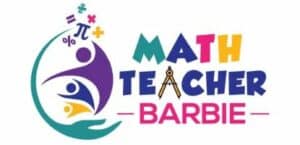This post contains affiliate links. If you purchase through these links, I may earn a small commission at no additional cost to you. You can read more about how I choose affiliates and products at my affiliate page.
This post was originally published on mathteacherbarbie.com. If you are reading this elsewhere, you are reading a stolen version.
Overview
Danielson’s subtitle for the book Which One Doesn’t Belong? is “playing with shapes.” Playful math is a specialty of Danielson across all of his professional work. This book is no exception and lives beautifully up to the subtitle. Inspired by the long-lived Sesame Street song and game (video link) about finding the items that don’t belong, each page of Danielson’s book invites the reader to explore the ways in which items on the page are both different and the same as each other. Unlike the Sesame Street game, however, each of the four items is both the same as the others and different than the others, providing a wide variety of possible answers.

This approach truly does make the book full of playful shapes conversation.
- Multiple “correct” answers encourage multiple children in a group (such as a class) to contribute their ideas. They also encourage individual children to keep exploring the shapes and investigate multiple characteristics.
- Children learn to examine the characteristics of shapes. These characteristics, after all, are what lead us to choosing which shapes are useful, how they are different from each other, and ultimately how we name and describe them. Motivating the need for the language before introducing the vocabulary is thought to be a powerful learning tool compared to giving the definitions and then seeking to connect the ideas.
- Flexibility in what’s observed allows the book to be read and reread over and over again either with or without repetition, depending on what the child desires
- Describing the “why” encourages children’s ability to adequately describe and explain, and sets the child up for future success in mathematical reasoning (in particular, the Common Core Mathematical Practice #2). Describing the “which” also improves children’t directional language.
How to Read/Use
You can use this book like other story books in your home. It can be straightforwardly read and the images enjoyed together just like any other picture book.
The book is easy to reread over and over again. At different developmental stages, individual children might appreciate either the repetition of describing the same results over and over, or the variance of observing and describing something new about each image.
The book can engage groups of either same-age or multi-age children, and even adults. Each reader can make choices and observations according to their own stage and observations. Many of the images include shapes that have multiple reasons they may or may not “belong.” The images are both complicated enough for multiple levels of observation as well as ease of explaining what the observation actually is.
Reading the book can easily be turned into a feel-good game between reader and child or within a small group. Try a cooperative challenge of finding how many ways items don’t belong. Or guess what characteristic each other examine based on the item they chose, or the item they chose based on the characteristic they described.
One common critique about this activity regards the language about “belonging.” Danielson himself reflects on this in a 2020 blog post. Some educators are finding ways to use the positive aspects of this activity while honoring that critique by changing the language a bit. Consider whether you are more comfortable asking “how is this one the same and different,” making a point of how each item both belongs with the rest and has unique characteristics, or similar. I suggest keeping a close eye on the language and social/emotional reactions you and your students are expressing during and after this activity and modifying or dropping accordingly.
There are a myriad ways to engage with this book both as parent-child as well as in group settings. I’m sure there are several I haven’t even thought of here.
Cultural and Educational Impact
With Which One Doesn’t Belong?, Danielson’s influence once again reaches deeply into social media. This social media influence has generated a wide range of both beautiful and everyday images to supplement those found in the book.
The #wodb hashtag is extremely popular across social media, and the website http://wodb.ca has examples for a wide variety of mathematical levels, ranging from preschool to high school and college. When you’ve thoroughly explored the book with your child, these hashtags provide a great source of both additional images as well as inspiration.
Which One Doesn’t Belong? has become a bit of a phenomenon in schools, and it’s likely your child has seen this activity in one or more classes. Its reach has gone well beyond math.
Author
A highly creative and engaging educator, Christopher Danielson describes himself as an “author, educator, dad.” He started teaching in the Minnesota K-12 schools in 1994, apparently focusing on middle school. After earning his PhD in 2005, he taught 10 years of college mathematics before leaning further into his entrepreneurial, creative, and coaching spirit. His work demonstrates a strong belief in exploring math through play. In addition to his books, Christopher has created and sells a variety of unusual tiling blocks and other tools that allow children, teens, and adults to explore mathematics through play. His tiling blocks in particular are used by an increasing number of high school teachers to engage students in creative mathematical thinking during transition times between classes.
Known as TriangleMan on various social media platforms, Christopher is often found inciting math teachers far and wide into playfully exploring ideas and principles in ways that encourage both collaboration and engagement with their students.
Christopher also created and manages the annual Math-On-A-Stick booth at the Minnesota State Fair. Here, families and individuals of all ages and interests can pause to play, explore, engage, and relate to each other through mathematical ideas — often without even realizing they’re doing math.
Final Thoughts
I recommend the book Which One Doesn’t Belong? to any parent or educator of young children who desires the close interaction of cuddling with a book. In fact, I have personally gifted it to preschools, teachers, and others. It is engaging, beautiful, flexible, immanently re-read-able, and exactly what any reader or group makes of it. It builds mathematical ideas around shapes, language, and characteristics in a playful but astonishingly deep way.
However, if you’re targeting older kids, you may wish to skip the book, but use the same principles on other images found in the social media hashtag #wodb and the website http://wodb.ca. Even if you do use the book, you may also find yourself seeking out these sources quickly to supplement the images there.
Which One Doesn’t Belong? comes in paperback, hardback, and bundled either with or without a teacher’s guide. However, I suggest the hardback book is all you’ll really need. You’ll find yourself reaching for it again and again, discovering each time a little more of its power in engaging and learning both for the children in your life as well as yourself.
